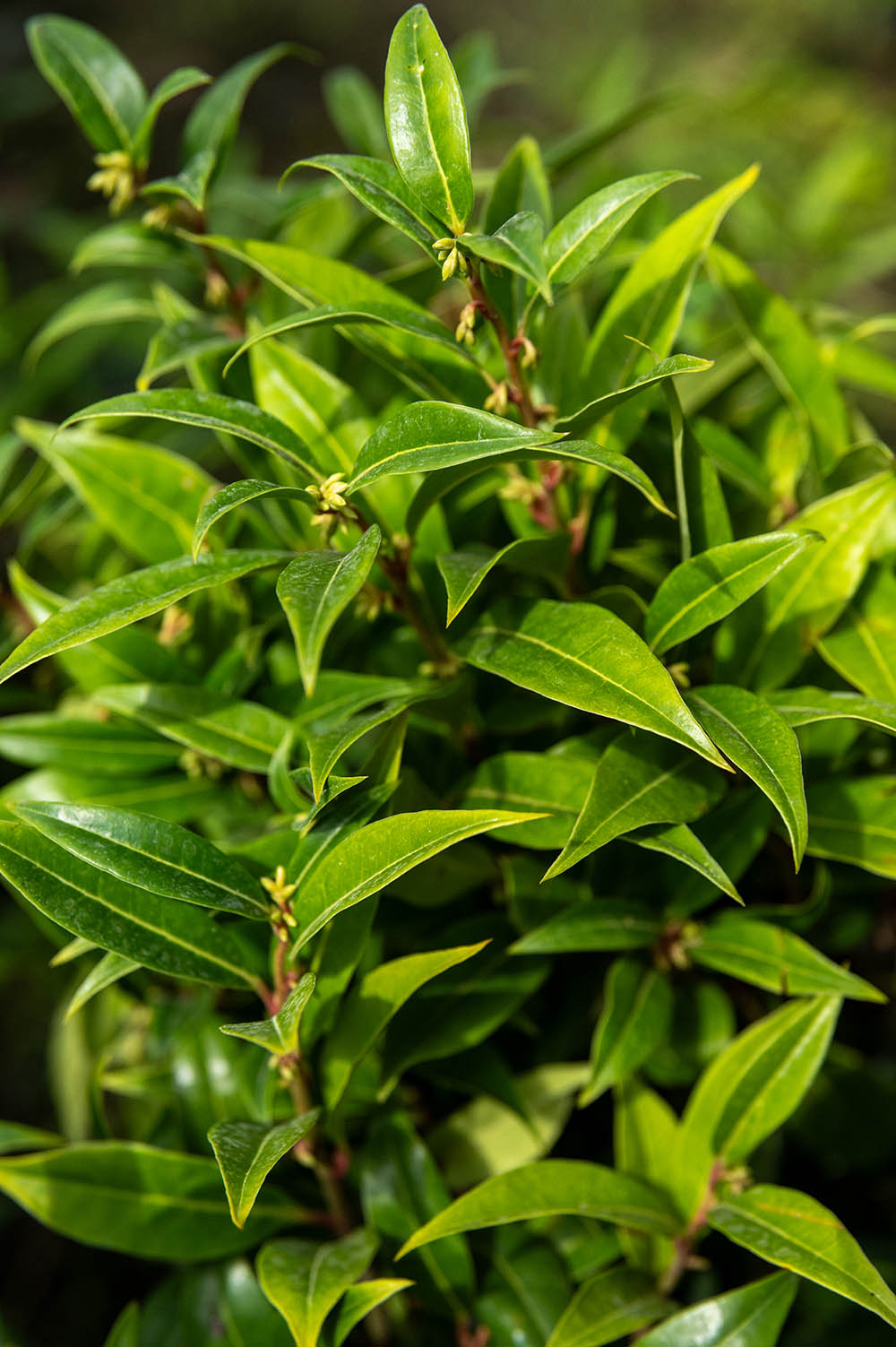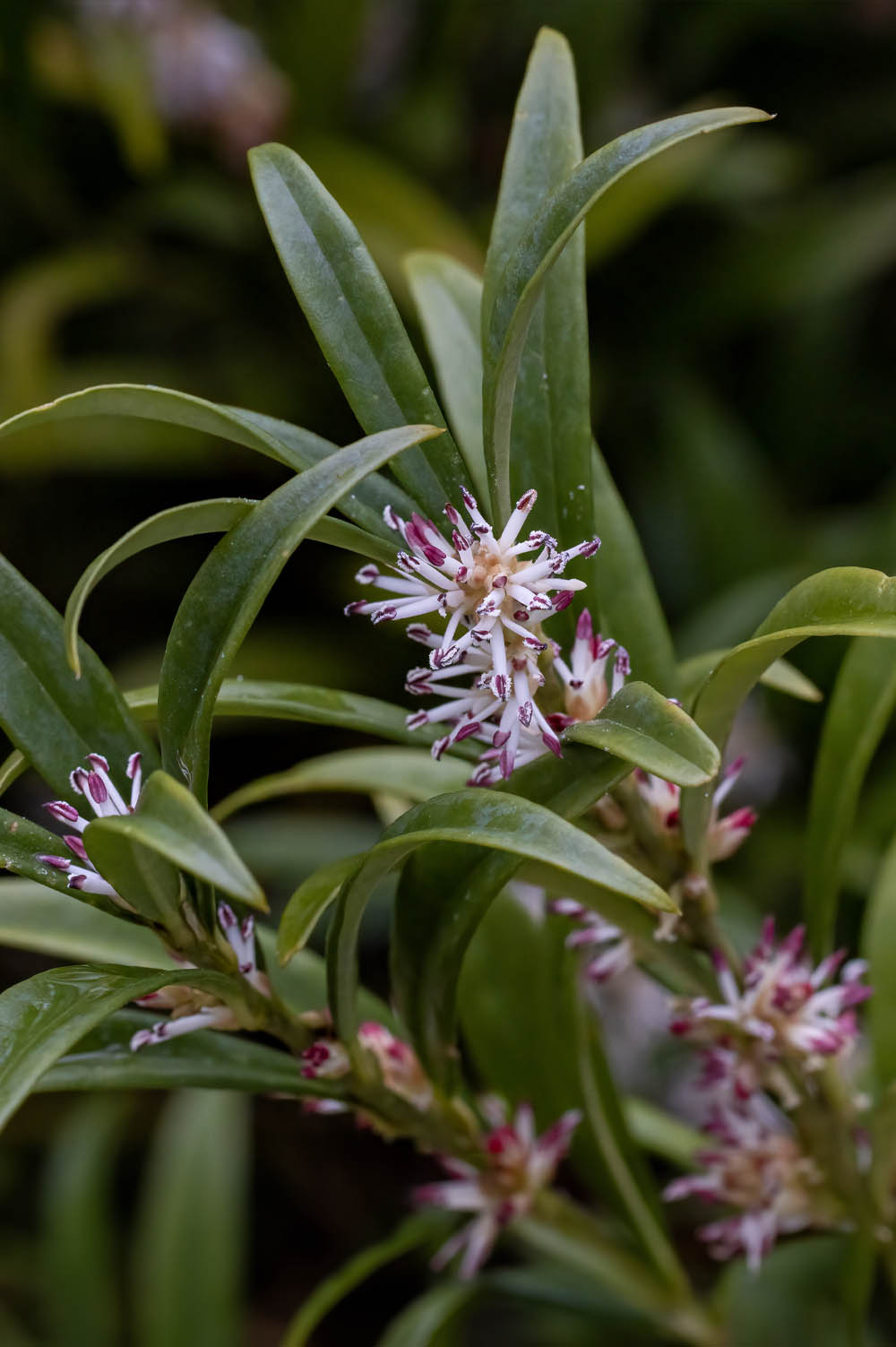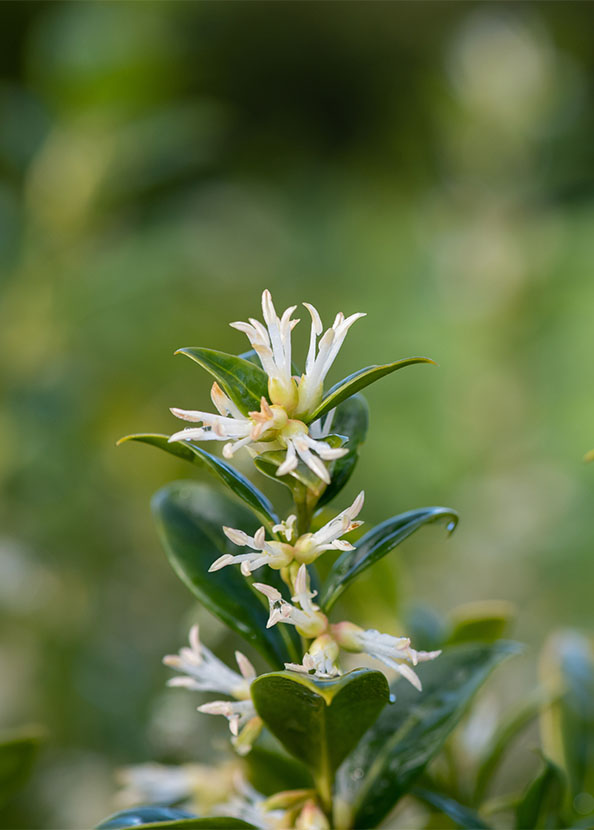Plant Focus: Sarcococca
An easy-to-grow fragrant evergreen shrub
Sarcococca, is a compact evergreen shrub that is native to Southeast Asia and the Himalayas. It is commonly known as ‘sweet box’ due to its vanilla fragrance, and generally grows up to a height around 1.5m. It is closely related to common box, Buxus sempervirens, but has sweeter smelling winter flowers. It adds an appeal to any garden with its heady fragrance and versatility.
Sarcococca thrives in shady areas, such as beneath trees or in woodland gardens. It compliments other winter flowering woodland plants, such as hellebores, crocus and snowdrops. It can also be grown as an informal, lightly clipped hedge along paths and entryways – ideal for adding evergreen structure as well as an appealing scent. They are low maintenance plants, so pruning is rarely required. Furthermore, these adaptable shrubs are tolerant of dry shade and even atmospheric pollution, making them a hardy addition to your outdoor space.
Key Characteristics of Sarcococca:
✓ Hardy, evergreen perennial plants
✓ Evergreen shrub
✓ Fragrant flowers in winter
✓ Thrives in partial to full shade
✓ Adaptable to various soil types
✓ Doesn’t generally need pruning
✓ Attracts wildlife
Sarcococca benefits wildlife by providing a source of food for bees during the winter months with its fragrant flowers. These are followed by berries that are enjoyed by birds. Not only this, but when planted as a hedge, it also provides shelter for all kinds of wildlife, including birds and invertebrates. Adding Sarcococca into your planting scheme not only enhances its aesthetic appeal, but it also promotes biodiversity within the surrounding environment. Its ability to thrive in shady, dry areas demonstrates its resilience and ability to adapt to challenging environments. As your clients’ landscapes change with the seasons, Sarcococca‘s evergreen structure and fragrant blooms in winter will undoubtedly become a valued highlight.
Our favourite Sarcococca varieties
Sarcococca confusa
An elegant shrub with ovate leaves that are lush, glossy, and dark green. During the winter, lovely white flowers exude a sweet fragrance before giving way to black berries. It tolerates dry shade and even urban pollution. It’s particularly captivating when incorporated into cottage or wildlife gardens.
Sarcococca hookeriana
A compact, bushy evergreen shrub with narrow green leaves. Its cream-colored flowers emit a rich fragrance and produce black berries. Plant it close to windows and entrances to ensure its scent is fully appreciated by visitors and landowners alike.
Sarcococca hookeriana digyna
A compact shrub with slender green leaves, and fragrant cream-colored flowers, that later give way to black berries. Ideal for use as an evergreen groundcover in damp, shady areas, adding both beauty and functionality to your landscape.

Sarcococca confusa

Sarcococca hookeriana ‘Purple Stem’
Sarcococca hookeriana humilis
A clump-forming shrub with narrow, glossy, green foliage and highly fragrant cream flowers, adorned with red anthers, which eventually turn into black berries. This variety also makes for a good choice when considering groundcover options.
Sarcococca hookeriana ‘Purple Stem’
A dense shrub with narrow green leaves and new shoots with an interesting purple hue. During the winter, it blooms with fragrant pink-white flowers that are followed by rounded blue-black berries. It not only offers visual appeal, but also attracts wildlife, making it a valuable addition to any landscape.
Sarcococca hookeriana ‘Winter Gem’
A hybrid of Sarcococca hookeriana ‘Purple Stem’ and Sarcococca hookeriana humilis, with lush green leaves. Its fragrant white winter flowers bloom from vibrant red buds, making for a striking display. This hybrid produces berries after the blooms, adding to its allure.

Sarcococca hookeriana ‘Winter Gem’

Sarcococca hookeriana

Sarcococca confusa
Fun Fact
The genus name is derived from the Greek word ‘sarx’ and ‘kokkos’ meaning fleshy berry.
How to grow and care for Sarcococca
Sarcococca is an adaptable shrub that can be planted at any time of year; however, they will achieve the best results when planted in spring or autumn. These shrubs prefer moist, but well-drained, organic-rich soil, but once established, they can tolerate dry shade as well. As a result, they are ideal for planting under trees or in shady areas. Sarcococca can grow in partial or full shade, and they do not require much sunlight to thrive.
Sarcococca is a low-maintenance shrub that requires minimal pruning as they are low-growing shrubs, compact, and well-branched. Watering your sarcococca thoroughly is vital in the first few seasons after planting, particularly during dry periods. It’s important to keep the soil consistently moist without overwatering. As the plant grows and establishes itself, its water requirements decrease significantly, and requires only minimal maintenance. Pruning in spring, after its flowering season, can help maintain their size and shape if they outgrow their designated space. Mulching the plant in spring with organic matter, helps to conserve moisture and suppress weeds. Additionally, removing any dead or damaged branches keeps it looking its best. Avoid cutting into old wood as this can reduce flowering the following year.
Pests & diseases that affect this genus
Sarcococca is generally considered to be a tough and disease-resistant plant, rarely affected by pests and resistant to deer and rabbits.
Aphids can gather on the leaves and stems, causing minor damage. However, Sarcococca is usually able to tolerate and recover from these infestations without significant harm. If aphid populations become a problem, then regular monitoring, and appropriate practices, such as using water sprays, can help keep them in check.
Another pest that can affect Sarcococca are scale insects. These tiny insects feed on the plant’s sap and can weaken the plant over time. This is easy to treat, though. Cutting off and disposing of the affected leaves will prevent scale insects from spreading.
Spider mites are another common pest to monitor. While feeding on the foliage, these pests spin webs around the shrub’s branches and leaves. They can cause yellowish spots to appear on the plant’s leaves. To combat these pests, you must first prevent them from reproducing. One method is to mist the affected plants with tepid water or use an organic pest control option such as insecticidal soap.
For further details on the Sarcococca varieties we grow and supply, and how they can add value to your planting schemes, get in touch with the G Team today.

